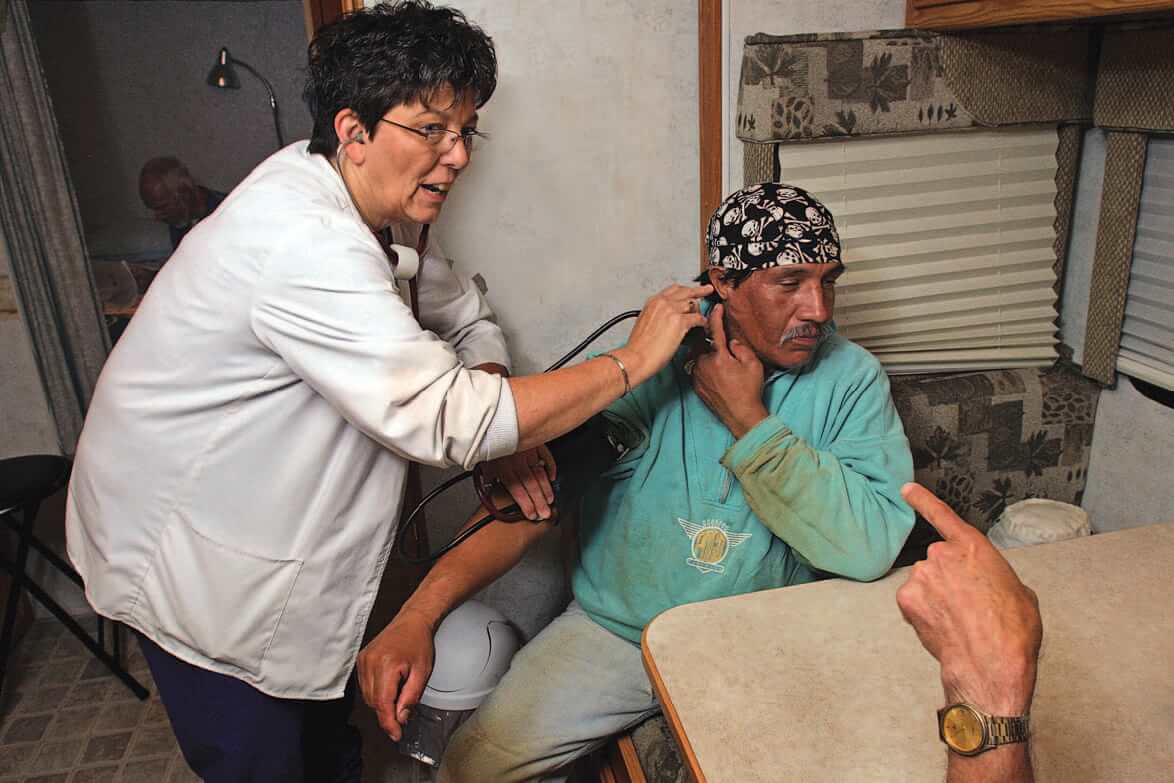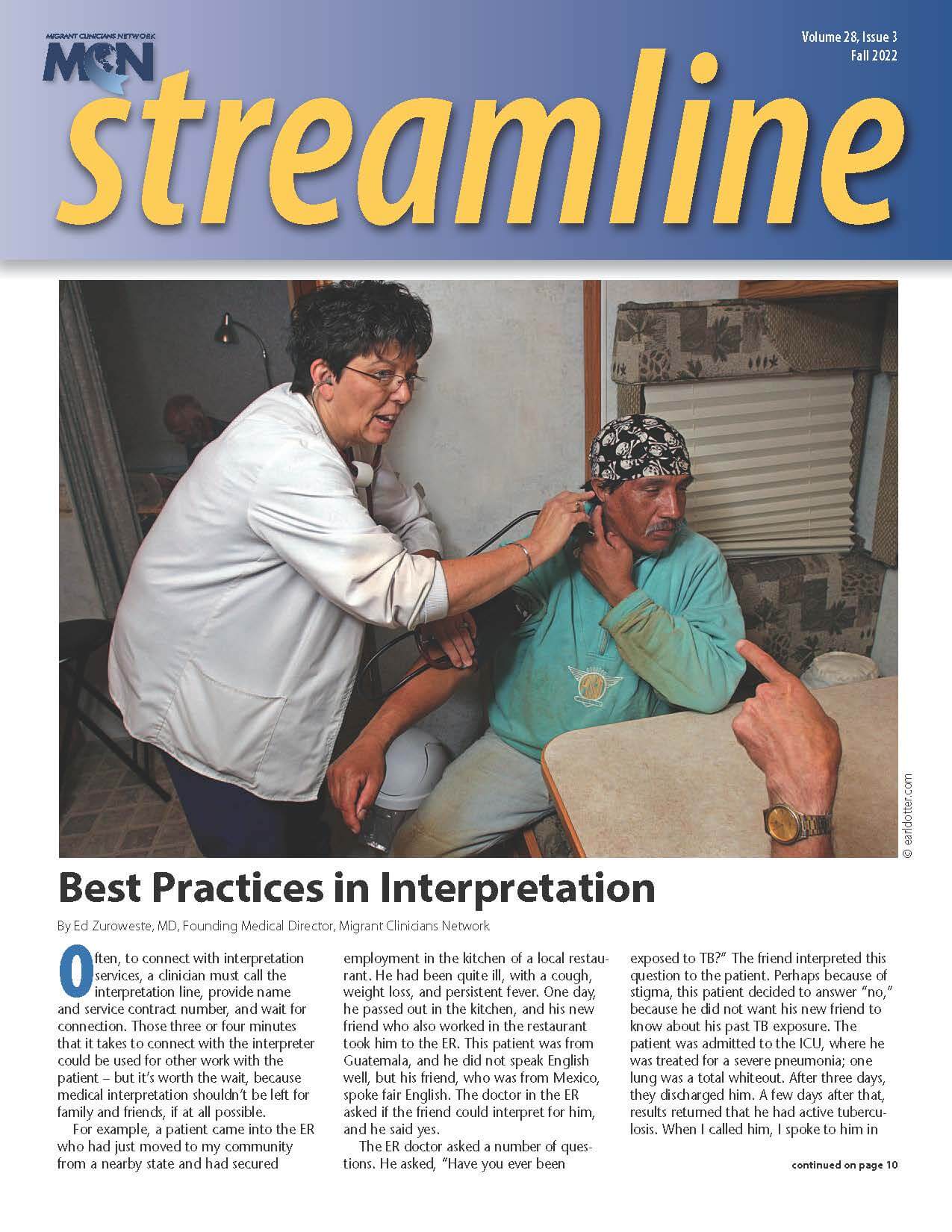
Often, to connect with interpretation services, a clinician must call the interpretation line, provide name and service contract number, and wait for connection. Those three or four minutes that it takes to connect with the interpreter could be used for other work with the patient – but it’s worth the wait, because medical interpretation shouldn’t be left for family and friends, if at all possible.
For example, a patient came into the ER who had just moved to my community from a nearby state and had secured employment in the kitchen of a local restaurant. He had been quite ill, with a cough, weight loss, and persistent fever. One day, he passed out in the kitchen, and his new friend who also worked in the restaurant took him to the ER. This patient was from Guatemala, and he did not speak English well, but his friend, who was from Mexico, spoke fair English. The doctor in the ER asked if the friend could interpret for him, and he said yes.
The ER doctor asked a number of questions. He asked, “Have you ever been exposed to TB?” The friend interpreted this question to the patient. Perhaps because of stigma, this patient decided to answer “no,” because he did not want his new friend to know about his past TB exposure. The patient was admitted to the ICU, where he was treated for a severe pneumonia; one lung was a total whiteout. After three days, they discharged him. A few days after that, results returned that he had active tuberculosis. When I called him, I spoke to him in Spanish. I introduced myself as a doctor with the state’s Department of Health and asked how he was doing.
The first thing he said to me was: “I hope I don’t die of TB.”
Upon further questioning, the patient confided that his uncle had died of TB the year before, and he had taken care of him before his death in Guatemala. Then, after he and his brother moved to the US, his brother had been diagnosed and treated for TB in another state.
I consulted his records; in the ICU, a pulmonologist noted, “history per ER interpreted.” No other interpreted history had been taken than what the friend from his work had provided.
Situations like this one are all too common. Without official interpretation, the medical history may miss key components. When a daughter is interpreting for the patient, a gynecologist might not ask the same questions about sexual behavior and STIs, or the mother will not confide that the pregnancy was the result of rape. Or, the nuances of the question may be left out or misunderstood, when the interpreter’s English or other language is not sufficiently strong.
To get the most out of interpretation, here are some best practices to follow:
- Use interpretation – even when the patient speaks English fairly well. As you know, medical language requires nuance and vocabulary that an interpreter can easily provide. It’s worth the extra minutes.
- Don’t forget that the friend who offers to interpret might not speak the second language as strongly as they suggest. Clinicians here in the US can generally quickly evaluate a patient's English language skills, but cannot evaluate a volunteer interpreter's command of the second language to be used in the exam room. This is another benefit of taking advantage of interpretation services.
- Consider the culture. Interpretation can be difficult in cultures where certain personal health topics are not frequently broached or for which there is a strong stigma in that culture.
- Encourage the entire team to use interpretation services. During intake and vitals, patients who are left without interpretation may feel that their care is not as high priority as for English-speaking patients. If the handoff between the team and the clinician is instantaneous, then the interpreter can stay on the line, saving the initial set-up minutes.
- Talk to the patient, not the phone. When asking a question, make eye contact when culturally appropriate. This helps you build a relationship with the patient, who can register your friendly warm smile, or read your concerned body language. It will also encourage the patient to do the same, to look at the clinician instead of the phone when speaking.
- Read the patient’s body language. Similarly, when the interpreter is talking to the patient, the clinician can pick up very important communication – did the patient respond with a feeling of comfort and warmth? Did the patient begin to shake her head, cross her arms, furrow her brow? Then the clinician can follow up after that question and ask, “It appears that you were upset by that question. Why?” Or another question that takes into account their emotional response.
- Use the “teach back” technique whenever possible. Follow up to make sure the patient understands by asking if they have questions and asking them to repeat back what you have shared. When using an interpreter, because of the extra time taken to have each sentence in two languages, this step can too often be left off when it is a critical step to ensure the patient understands.
- Check in with family members. If there are others in the room, be sure to ask if they have questions as well, to weigh in on the patient’s treatment and ensure full buy-in by everyone in attendance.
- Break the rule when it may be to the patient’s advantage. In an extreme emergency when vital history may be lifesaving, use whoever you can to get the necessary history. Or, on very rare occasions, a family member who offers to interpret may have recently completed treatment for the health concern that the patient is considering. In this case – while also taking into account culture, language level, and confidentiality – having the family member interpret may act as a selling point.
- When stuck with non-professional interpretation, lay down the ground rules. In a refugee camp or in an emergency situation outside of the exam room, tell the person who has accepted interpreting duties to repeat exactly what is said. For example, start by saying, “Please introduce yourself to the patient and let them know you will say everything that I am going to say. Please let me know if there are things you feel uncomfortable translating and I can try to reword.” Make extra sure, in this case, that your communications are clear and jargon-free.
Interpretation is only getting more complex. In one recent case, a nurse made a home visit, where she and the patient video conferenced with me as the doctor on one device, while calling the interpreter on a second device. But this four-way call was successful: the patient got the care she needed, in her language of choice, at home. As care gets more complicated, interpretation must be built into the changing workflows and technology platforms. It can be cumbersome and time-intensive – but it also lifesaving and ensures the patient gets the most out of their visit.
 |
Read this article in the Fall 2022 issue of Streamline here!Sign up for our eNewsletter to receive bimonthly news from MCN, including announcements of the next Streamline. |